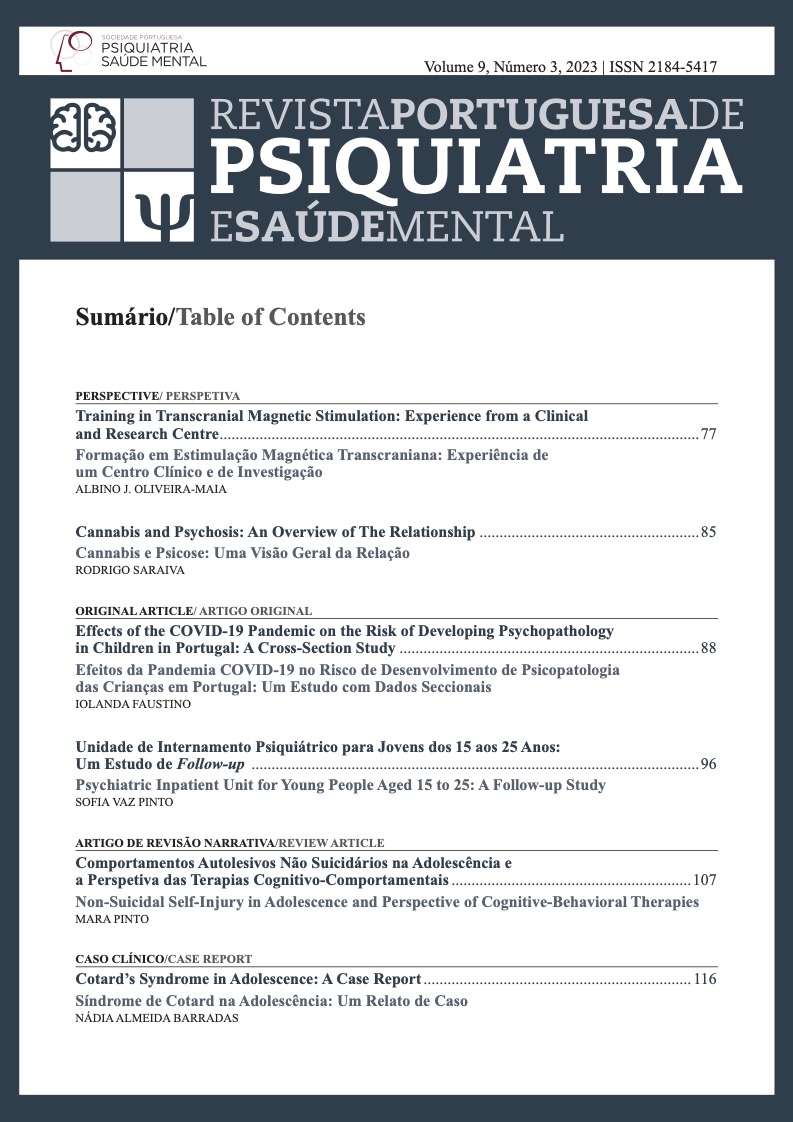Psychiatric Inpatient Unit for Young People Aged 15 to 25: A Follow-up Study
DOI:
https://doi.org/10.51338/rppsm.448Keywords:
Adolescent Psychiatry, Child Psychiatry, Follow-Up Studies, Inpatients, Mental DisordersAbstract
Introduction: Adolescence and early adulthood are life stages characterized by significant physical, psychological, and social transformations. The transitional age, between 15 and 25 years old, is considered a high-risk period for the development of psychopathology, representing a critical period of opportunities and challenges for mental
health intervention. Our objective was to do 4-year follow-up study was conducted on young individuals who were hospitalized during the year 2018 in the acute psychiatric inpatient unit Unidade Partilhada, dedicated to individuals aged 15 to 25 years old. The aim was to assess the sociodemographic and clinical characteristics of the sample, inpatient characteristics, rehospitalization rate, psychopathological status, quality of life, satisfaction with the provided care, and maintenance of follow-up appointments; establishing relationships between the mentioned variables.
Methods: Standardized telephone interviews were conducted using the reduced version of the Mental Health Inventory (MHI) and the World Health Organization’s Abbreviated Instrument for Quality of Life Assessment. Clinical records were also consulted.
Results: There was a higher percentage of female patients (52.1%). The discharge diagnosis of mood disorders (54.3%) was significantly higher in females, while psychotic disorders (23.4%) were significantly higher in males (Fisher = 40; p<0.001). The duration of hospitalization (average=16.1 days; SD=13.6 days) was significantly longer for psychotic disorders compared to mood disorders (p=0.009). A percentage of 41.5% of young individuals were readmitted, with 6.3% readmitted within 30 days and 35.2% readmitted within 365 days. At the time of the follow-up interview, 80.9% considered themselves “better,” and 62.7% reported being “satisfied” or “very satisfied” with their lives. A percentage of 74.5% continued to receive outpatient care, with significantly lower MHI scores observed among individuals without current follow‐up. A percentage of 37.2% reported being “very satisfied” or “extremely satisfied” with the care provided.
Conclusion: Obtaining knowledge and data that allow for the characterization of psychiatric hospitalization during the transitional age is fundamental for the planning, organization, and optimization of care provided to this population. Valuing patient opinions and fostering closer relationships between healthcare professionals and young patients promotes treatment adherence.
Downloads
References
Oliveira P, Ribeiro J, Morais S, Santos V, Madeira N. Internamentos Psiquiátricos no Adulto Jovem: Um Estudo Observacional em 2006-2016. Rev Serv Psiquiatr Hosp Prof Doutor Fernando Fonseca. 2017;15:43–9.
Wasserman D, Cheng Q, Jiang GX. Global suicide rates among young people aged 15-19. World Psychiatry. 2005;4:114-20.
Fernandes R, Costa C, Martins M, Salgado J. Lost in transition: From child and adolescent psychiatry to adult mental health care. Acta Med Port. 2020;33:777. doi:10.20344/amp.14802 DOI: https://doi.org/10.20344/amp.14802
Sampaio D. Nínguem morre sozinho. Lisboa: CAMINHO; 1991.
Goldschmidt T, Marques C, Xavier M. Psiquiatria da Infância e da Adolescência ‐ Rede de Referenciação Hospitalar Psiquiatria da Infância e da Adolescência. Lisboa: República Portuguesa Saúde; 2018.
Kessler RC, Amminger GP, Aguilar-Gaxiola S, Alonso J, Lee S, Üstün TB. Age of onset of mental disorders: A review of recent literature. Curr Opin Psychiatry. 2007;20:359–64. doi:10.1097/YCO.0b013e32816ebc8c DOI: https://doi.org/10.1097/YCO.0b013e32816ebc8c
Patton GC, Coffey C, Romaniuk H, Mackinnon A, Carlin JB, Degenhardt L, et al. The prognosis of common mental disorders in adolescents: A 14-year prospective cohort study. Lancet. 2014;383:1404–11. doi:10.1016/S0140-6736(13)62116-9 DOI: https://doi.org/10.1016/S0140-6736(13)62116-9
Salgado J. A Transição de Serviços de Saúde de Crianças e Jovens para Serviços de Saúde de Adultos: Uma Realidade com Impacto no Prognóstico. Acta Med Port. 2022;35:161–3. doi:10.20344/amp.15912 DOI: https://doi.org/10.20344/amp.15912
McDonagh JE, Viner RM. Lost in transition? Between paediatric and adult services. Br Med J. 2006;332:435– 6. doi:10.1136/bmj.332.7539.435 DOI: https://doi.org/10.1136/bmj.332.7539.435
Wasserman D. A Stress-Vulnerability Model and the Development of the Suicidal Process. Suicide. 2001:13–27. DOI: https://doi.org/10.1201/b14713-5
World Health Organization. Manual de Políticas e Estratégias para a Qualidade dos Cuidados de Saúde. Genebra: WHO; 2020.
Organização Mundial de Saúde. Mental Health: New Understanding, New Hope. World Heal Rep. 2001:206.
Oliveira AR, Azevedo SM. Estigma na doença mental. Rev Port Med Geral E Fam. 2014;30:221–34. DOI: https://doi.org/10.32385/rpmgf.v30i4.11347
Ribeiro J. Mental Health Inventory: um estudo de adaptação à população portuguesa. Psicol Saúde Doenças. 2001;2:77–99.
Power M, Kuyken W. World Health Organization Quality of Life Assessment (WHOQOL): Development and general psychometric properties. Soc Sci Med. 1998;46:1569–85. doi:10.1016/ S0277-9536(98)00009-4 DOI: https://doi.org/10.1016/S0277-9536(98)00009-4
Serra AV, Canavarro MC, Simões MR, et al. 2006 Estudos psicométricos do WHOQOL-Bref.pdf. Psiquiatr Clínica. 2006;27:41–9.
Saxena S, Carlson D, Billington R, Orley J. The who quality of life assessment instrument (WHOQOL-Bref): The importance of its items for cross-cultural research. Qual Life Res. 2001;10:711–21. doi:10.1023/A:1013867826835 DOI: https://doi.org/10.1023/A:1013867826835
Maroco J. Análise Estatística com o SPSS Statistics. 5a ed. Lisboa: Edições Report Number; 2011.
Pestana MH, Gagueiro JN. Análise de dados para Ciências Sociais - A complementaridade do SPSS. 5a ed. Lisboa: Edições Sílabo; 2008.
Eaton N, Krueger R, Andrew S, Balsis S, Skodol AE, Markon KE, et al. An invariant Dimensional Liability Model of Gender Differences in Mental Disorder Prevalence: Evidence From a National Sample. J Abnorm Psychol. 2012;121:282–8. doi:10.1016/j. jpsychires.2015.03.017 DOI: https://doi.org/10.1037/a0024780
Suanrueang P, Peltzer K, Suen MW, Lin HF, Er TK. Trends and Gender Differences in Mental Disorders in Hospitalized Patients in Thailand. Inq J Heal Care Organ Provision Financ. 2022;59:1–14. doi:10.1177/00469580221092827 DOI: https://doi.org/10.1177/00469580221092827
Carter B, Wootten J, Archie S, Terry AL, Anderson KK. Sex and gender differences in symptoms of early psychosis: a systematic review and meta-analysis. Arch Womens Ment Heal. 2022;25:679–91. DOI: https://doi.org/10.1007/s00737-022-01247-3
Giordano GM, Bucci P, Mucci A, Pezzella P, Galderisi S. Gender Differences in Clinical and Psychosocial Features Among Persons With Schizophrenia: A Mini Review. Front Psychiatry. 2021;12:1–10. doi:10.3389/ fpsyt.2021.789179 DOI: https://doi.org/10.3389/fpsyt.2021.789179
Instituto Nacional de Estatística. População residente (N.o) por Local de residência (à data dos Censos 2011), Sexo, Grupo etário, Estado civil e Relação de conjugalidade; Decenal - INE, Recenseamento da população e habitação - Censos 2011. [Acedido Novembro 13, 2022] Disponível em: https://www.ine.pt/xportal/xmain?xpid=INE&xpgid=ine_indicadores&indOcorr-Cod=0006364&contexto=bd&selTab=tab2.
Instituto Nacional de Estatística. Taxa de desemprego (Série 2021 - %) por Sexo, Grupo etário e Nível de escolaridade mais elevado completo; Trimestral - INE, Inquérito ao emprego (Séries - 2021). [Acedido Novembro 13, 2022] Disponível em: https://www.ine.pt/ xportal/xmain?xpid=INE&xpgid=ine_indicadores&in-dOcorrCod=0010705&contexto=bd&selTab=tab2.
Link B. Mental Patient Status, Work, and Income: An Examination of the Effects of a Psychiatric Label. Am
Sociol Assoc. 1982;47:202–15. doi:10.2307/2094963 27. Bond N, D ́Arcy C. Mind the Income Gap: how work and social security shape the incomes of people with mental health problems. Money Ment Heal Poslicy Inst. 2020.
INE. Indicadores fundamentais de saúde apontam para melhoria nos anos recentes, embora alguns mantenham níveis inferiores aos médios da União Europeia (UE-28). Destaque - Informação à Comun Soc. 2020:1–16.
Almeida F, Marques A, Castro C, Palha J, Carneiro L. Internamentos compulsivos no Hospital Magalhães Lemos. Psiquiatr Psicol Justiça. 2008;2:87–102.
Huntley DA, Cho DW, Christman J, Csernansky JG. Predicting Length of Stay in an Acute Psychiatric Hospital. Psychiatr Serv. 1998;49:1049–53. doi:10.1176/ ps.49.8.1049 DOI: https://doi.org/10.1176/ps.49.8.1049
Chang G, Brenner L, Bryant K. Factors predicting inpatient length of stay in a CMHC. Hosp Community Psychiatry. 1991;42:853–5. doi:10.1176/ps.42.8.853 DOI: https://doi.org/10.1176/ps.42.8.853
Tulloch AD, Fearon P, David AS. Length of stay of general psychiatric inpatients in the United States: Systematic Review. Adm Policy Ment Heath. 2011;38:155–68. doi:10.1007/s10488-010-0310-3 DOI: https://doi.org/10.1007/s10488-010-0310-3
Lassemo E, Myklebust LH, Salazzari D, Kalseth J. Psychiatric readmission rates in a multi-level mental health care system – a descriptive population cohort study. BMC Health Serv Res. 2021;21:1–15. doi:10.1186/s12913-021-06391-7 DOI: https://doi.org/10.1186/s12913-021-06391-7
Ortiz G. Predictors of 30-day Postdischarge Readmission to a Multistate National Sample of State Psychiatric Hospitals. J Healthc Qual. 2018;00:1–9. doi:10.1097/JHQ.0000000000000162 DOI: https://doi.org/10.1097/JHQ.0000000000000162
Katschnig H, Straßmayr C, Endel F, Berger M, Zauner G, Kalseth J, et al. Using national electronic health care registries for comparing the risk of psychiatric re-hospitalisation in six European countries: Opportunities and limitations. Health Policy. 2019;123:1028–35. doi:10.1016/j.healthpol.2019.07.006 DOI: https://doi.org/10.1016/j.healthpol.2019.07.006
Kernberg PF, Weiner AS, Bardenstein KK. Personality Disordders in Children and Adolescents. Phiadelphia: Basic Books; 2000.
Coimbra de Matos A. Adolescência. Lisboa: Climepsi Editores; 2002.
Mendes P, Fonseca M, Aguiar I, Pangaio N, Confraria L, Queirós O, et al. Reinternamentos Hospitalares num Serviço de Pedopsiquiatria: Taxa de Readmissão e Fatores de Risco Acta Med Port. 2017;30:769-74. doi: 10.20344/amp.8842. DOI: https://doi.org/10.20344/amp.8842
Cramer V, Torgersen S, Kringlen E. Mood disorders and quality of life. A community study. Nord J Psychiatry. 2010;64:58–62. doi:10.3109/08039480903287565 DOI: https://doi.org/10.3109/08039480903287565
Hohls JK, König H-H, Quirke E, Hajek A. Association between anxiety, depression and quality of life: study protocol for a systematic review of evidence from longitudinal studies. BMJ Open. 2019;9:1–5. doi:10.1136/bmjopen-2018-027218 DOI: https://doi.org/10.1136/bmjopen-2018-027218
Aghababian V, Auquier P, Baumstarck-Barrau K, Lançon C. Influence des troubles de la conscience sur l’auto-évaluation de la qualité de vie des patients souffrant de schizophrénie. Encephale. 2010;37:162–71. doi:10.1016/j.encep.2010.08.011 DOI: https://doi.org/10.1016/j.encep.2010.08.011








